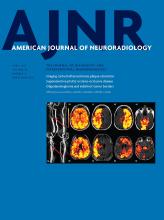Research ArticlePediatric Neuroimaging
Open Access
Measurement of Lactate Content and Amide Proton Transfer Values in the Basal Ganglia of a Neonatal Piglet Hypoxic-Ischemic Brain Injury Model Using MRI
Y. Zheng and X.-M. Wang
American Journal of Neuroradiology April 2017, 38 (4) 827-834; DOI: https://doi.org/10.3174/ajnr.A5066
Y. Zheng
aFrom the Department of Radiology, Shengjing Hospital of China Medical University, Shenyang, PR China.
X.-M. Wang
aFrom the Department of Radiology, Shengjing Hospital of China Medical University, Shenyang, PR China.

REFERENCES
- 1.↵
- 2.↵
- 3.↵
- 4.↵
- Schurr A,
- Payne RS
- 5.↵
- 6.↵
- 7.↵
- Khong PL,
- Tse C,
- Wong IY, et al
- 8.↵
- 9.↵
- 10.↵
- Zhou J,
- Payen JF,
- Wilson DA, et al
- 11.↵
- 12.↵
- 13.↵
- 14.↵
- Sun PZ,
- Benner T,
- Copen WA, et al
- 15.↵
- Zhou J,
- Wilson DA,
- Sun PZ, et al
- 16.↵
- Wang XY,
- Wang HW,
- Fu XH, et al
- 17.↵
- Munkeby BH,
- De Lange C,
- Emblem KE, et al
- 18.↵
- 19.↵
- Katsura K,
- Asplund B,
- Ekholm A, et al
- 20.↵
- 21.↵
- 22.↵
- 23.↵
- 24.↵
- 25.↵
- 26.↵
- 27.↵
- 28.↵
- Hamakawa H,
- Murashita J,
- Yamada N, et al
- 29.↵
- Casey JR,
- Grinstein S,
- Orlowski J
- 30.↵
- 31.↵
- Levine SR,
- Helpern JA,
- Welch KM, et al
- 32.↵
- Welch KM,
- Levine SR,
- Helpern JA
- 33.↵
- Robertson NJ,
- Cowan FM,
- Cox IJ, et al
- 34.↵
- Brown AM,
- Ransom BR
- 35.↵
- Mehta SL,
- Manhas N,
- Raghubir R
- 36.↵
- 37.↵
- Dienel GA,
- Hertz L
- 38.↵
- Hertz L,
- Dienel GA
- 39.↵
- Mabe H,
- Blomqvist P,
- Siesjö BK
- 40.↵
- Allen K,
- Busza AL,
- Crockard HA, et al
- 41.↵
- Kauppinen RA,
- Williams SR
- 42.↵
- 43.↵
- Groenendaal F,
- Veenhoven RH,
- van der Grond J, et al
- 44.↵
- Ling W,
- Regatte RR,
- Navon G, et al
- 45.↵
- Provencher S
- 46.↵
- 47.↵
- 48.↵
- 49.↵
- Roohey T,
- Raju TN,
- Moustogiannis AN
- 50.↵
- 51.↵
- 52.↵
- 53.↵
In this issue
American Journal of Neuroradiology
Vol. 38, Issue 4
1 Apr 2017
Advertisement
Y. Zheng, X.-M. Wang
Measurement of Lactate Content and Amide Proton Transfer Values in the Basal Ganglia of a Neonatal Piglet Hypoxic-Ischemic Brain Injury Model Using MRI
American Journal of Neuroradiology Apr 2017, 38 (4) 827-834; DOI: 10.3174/ajnr.A5066
0 Responses
Jump to section
Related Articles
- No related articles found.
Cited By...
- Lactate receptor HCAR1 regulates neurogenesis and microglia activation after neonatal hypoxia-ischemia
- Lower Lactate Levels and Lower Intracellular pH in Patients with IDH-Mutant versus Wild-Type Gliomas
- Expression Changes in Lactate and Glucose Metabolism and Associated Transporters in Basal Ganglia following Hypoxic-Ischemic Reperfusion Injury in Piglets
This article has not yet been cited by articles in journals that are participating in Crossref Cited-by Linking.
More in this TOC Section
Similar Articles
Advertisement











